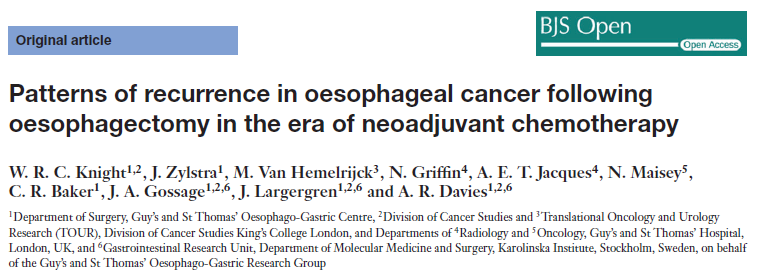Comment on recent publication : Understanding recurrence patterns after cancer surgery is very important because it provides an understanding of where treatments are failing and what improvements in decision making could improve outcomes. In this large series of consecutive patients treated at Guy’s & St Thomas’, key predictors of both local and systemic relapse were identified. The former group could conceivably benefit from the addition of radiotherapy to their treatment algorithms whilst the latter group (as with most oesophageal cancer patients) require more effective systemic thearpy.
Background:
Tumour recurrence following oesophagectomy for oesophageal cancer is common despite neoadjuvant treatment. Understanding patterns of recurrence and risk factors associated with locoregional and systemic recurrence might influence future treatment strategies.
Methods:
This was a cohort study involving patients undergoing resection for adenocarcinoma or squamous cell carcinoma of the oesophagus between 2000 and 2014. Clinicopathological factors associated with locoregional and systemic recurrence were analysed using multivariable logistic regression to determine odds ratios (ORs) and 95 per cent confidence intervals.
Results:
Some 698 patients were identified. Lymphovascular invasion (OR 2·09, 95 per cent c.i. 1·18 to 3·71) and preoperative stenting (OR 3·70, 1·34 to 10·23) were independent risk factors for isolated locoregional recurrence. Pathological nodal disease in patients with pT1-2 (pN1: OR 2·72, 1·35 to 5·48; pN2-3: OR 5·00, 2·35 to 10·66) or pT3-4 (pN1: OR 3·03, 1·51 to 6·07; pN2-3: OR 5·75, 3·15 to 10·49) disease predisposed to systemic recurrence. Poor or no response to chemotherapy was also an independent risk factor for isolated systemic recurrence (OR 1·85, 1·05 to 3·26). A positive resection margin (R1 resection) was not associated with a significantly increased risk of isolated locoregional recurrence (OR 1·37, 0·81 to 2·33).
Conclusion:
These findings confirm that oesophageal adenocarcinoma is frequently a systemic disease. Understanding the key predictors of local and systemic recurrence may facilitate the tailoring of oncological therapies to the individual patient.





